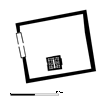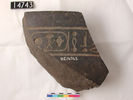| Homepage | Timeline | Maps | A-Z index | Learning |
Late Period and early Ptolemaic Period architecture
The economic and political centres of the country moved in the Third Intermediate and Late Period into the Delta. Few remains of the building activities there have survived. The preservation conditions in the Delta are poor, in comparison with Upper Egypt; the Delta was always a region with high population density. Buildings have generally been extensively destroyed, often being entirely quarried away.
(click on the images for further information)
Palaces
At Memphis substantial parts of a palace building have survived. The palace
was built on a platform, like some other Egyptian (Deir
el-Ballas) and Near Eastern palace buildings (Khorsabad).
Most of the walls are constructed in mud-brick, while important elements such
as columns, pavements and wall cladding (at least to a certain height) are
made in limestone.
 |
the palace of Apries at Memphis |
Temples
From many Late Period temples only the mud brick built enclosure walls survived; probably most cult centres were provided with very thick enclosure walls at this time. The temples themselves have generally been stripped of most of their stone, often leaving only hard stone elements such as door-jambs and monolithic shrines.
 |
The 'Great Temenos' at Naukratis, built in the early Ptolemaic Period, but very close in style to Late Period temple complexes. |
 |
The temple complex at Tell el-Balamun, built and rebuilt by several kings of the Late Period. |
Platforms
A feature of many monumental buildings in the Late Period (although already earlier attested) are huge platforms on which the main structures were placed. Typically there are casemates in these platforms, to give them higher stability: they should not be confused with rooms. Platforms are found in connection with palace buildings (palace of Apries), and fortresses built into temple complexes (see temples above).
Kings tombs
Kings of the Third Intermediate and Late Period were buried in small chambers, which were placed inside temple enclosures. This type of location, not previously known for royal tombs, has several possible reasons:
